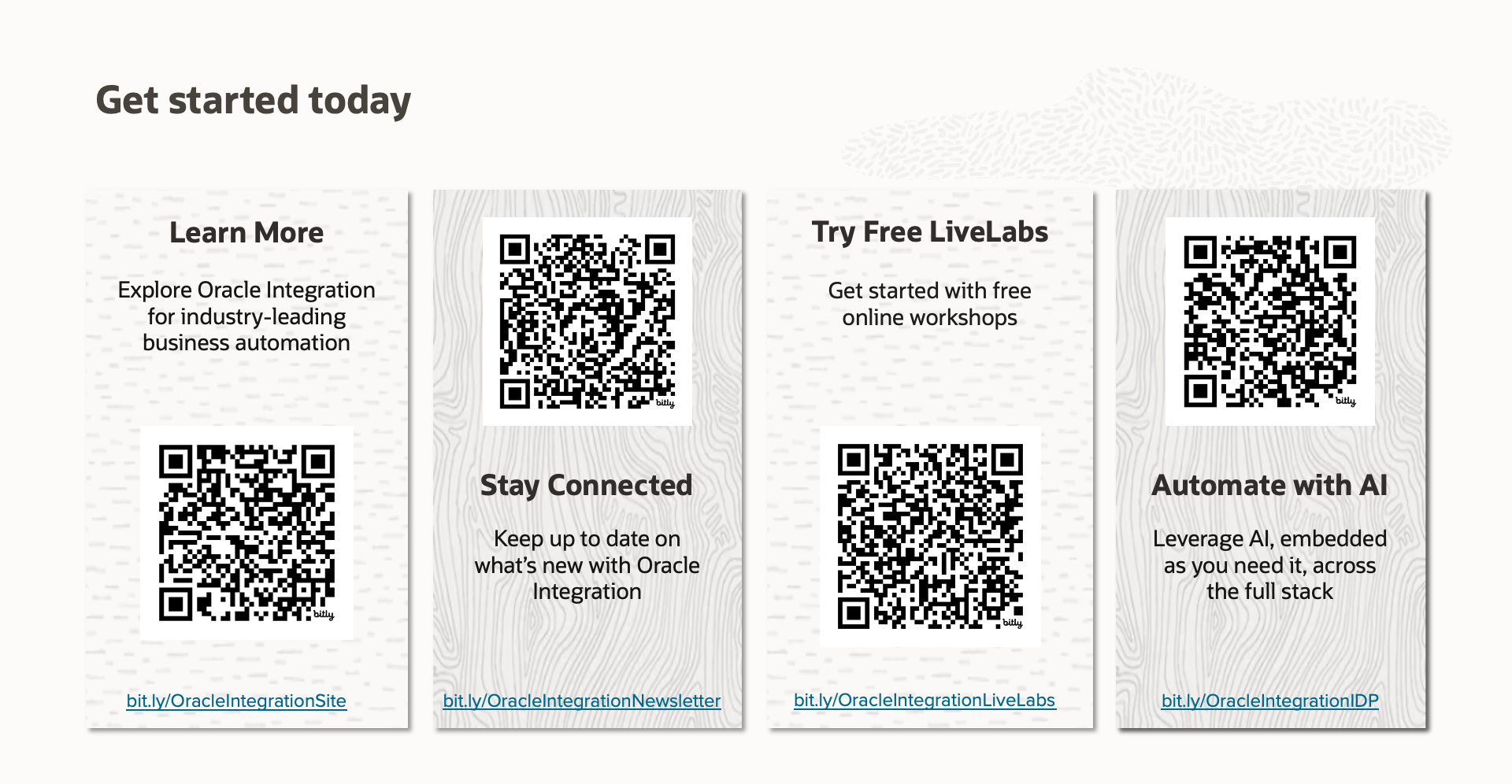Oracle Integration
Oracle Integration (OIC) has been an industry-leading Integration Platform as a Service (iPaaS) product for many years. Throughout this time, the product has evolved to meet the dynamic needs of modern businesses. Starting as a robust Integration platform that helped customers eliminate data silos and ensure data consistency across the enterprise, OIC stands today as a unified Business Automation platform helping customers connect apps and data, automate business processes, and innovate with AI.
Oracle Integration includes a comprehensive portfolio of business automation tools and technologies that help accelerate innovation. Its key automation capabilities include:
- Application Integration: eliminate data silos and ensure data consistency across the enterprise.
- Prebuilt Connectivity: lower the technical barriers to connecting Oracle and third-party Software-as-a-Service (SaaS) and on-premises applications, databases, internet technologies, and AI services.
- Prebuilt automation solutions: accelerate innovation through a marketplace of supported, extensible, and upgradable automation solutions for common horizontal and vertical business processes.
- Process Automation: engage human workers for approvals, exception handling, and AI human-in-the-loop oversight.
- Robotic Process Automation (RPA): automate manual repetitive tasks where you can’t use APIs.
- Decision Service: automate the enforcement of business policies and rules.
- Business to Business (B2B): automate business partner transactions and processes.
With the rapid emergence of new automation opportunities brought about by artificial intelligence (AI), businesses are once again faced with the challenge of remaining competitive as they navigate and capitalize on the promise of these transformative technologies. Building on our proven history of empowering customers through dynamic market changes, Oracle Integration is ready to deliver pragmatic solutions, leveraging our foundation of robust integration and automation capabilities, to help drive your AI innovation.
To that end, we are pursuing an AI strategy that delivers value across two pillars of innovation. First, we are bringing AI to Oracle Integration by embedding AI directly into the product to create intelligent features that enhance usability, increase productivity, and simplify operations. Second, we are bringing Oracle Integration to AI to help accelerate your AI innovation journey through our comprehensive portfolio of business automation tools and technologies.
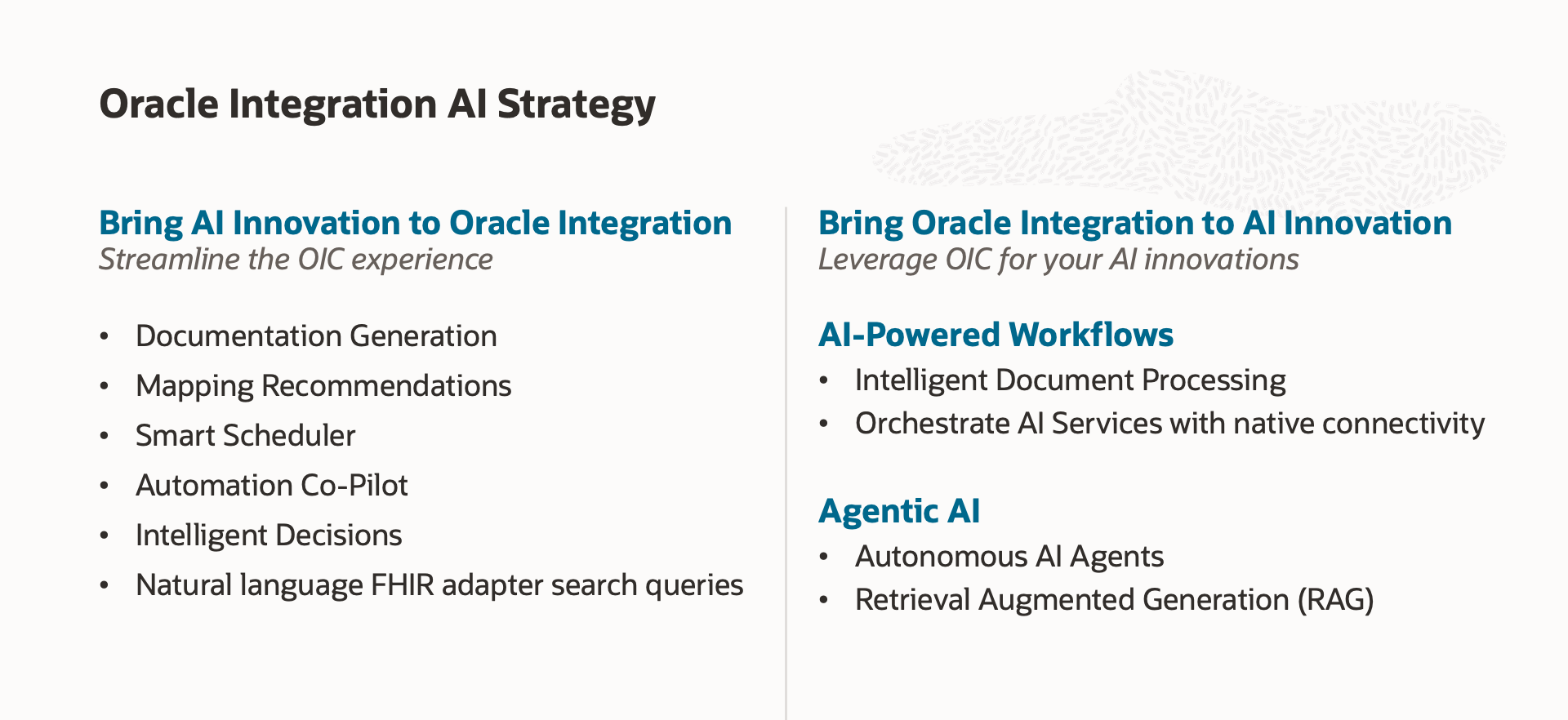
Bring AI to Oracle Integration
We are committed to optimizing Oracle Integration with embedded AI capabilities, making the platform experience more intuitive and productive. These enhancements aim to accelerate the creation of automated business processes, provide deeper insights into the technical and business impact of automations, and streamline the deployment and operation of automation solutions. Some representative areas we are bringing AI to Oracle Integration include:
- Code-Assist: provide contextual guidance throughout the product to automate the creation of automation components.
- Natural language code generation: interactive code generation such as FHIR search queries, JavaScript, and SQL.
- Automated documentation generation: provide comprehensive documentation for technical, business, and operational stakeholders to help them create, run, and maintain automation solutions.
- Mapping recommendations: provide mapping assistance between different systems or applications based on best practices, validated historic mappings, and intelligent pattern matching.
- Smart scheduler: define automation scheduling definitions based on natural language processing (NLP).
- Intelligent decisions: assess and enforce business policies and rules based on existing corporate policy documents.
- Proactive analytics: automatically identify process bottlenecks, SLA violations, missed system events or expected process triggers, and other automation anomalies.
You’ll see many of these AI driven productivity enhancements in the latest release of OIC, such as automated integration description generation, SQL code generation for Oracle Autonomous Database, and iCal code generation for the Integration scheduler, and many more throughout the next several releases.
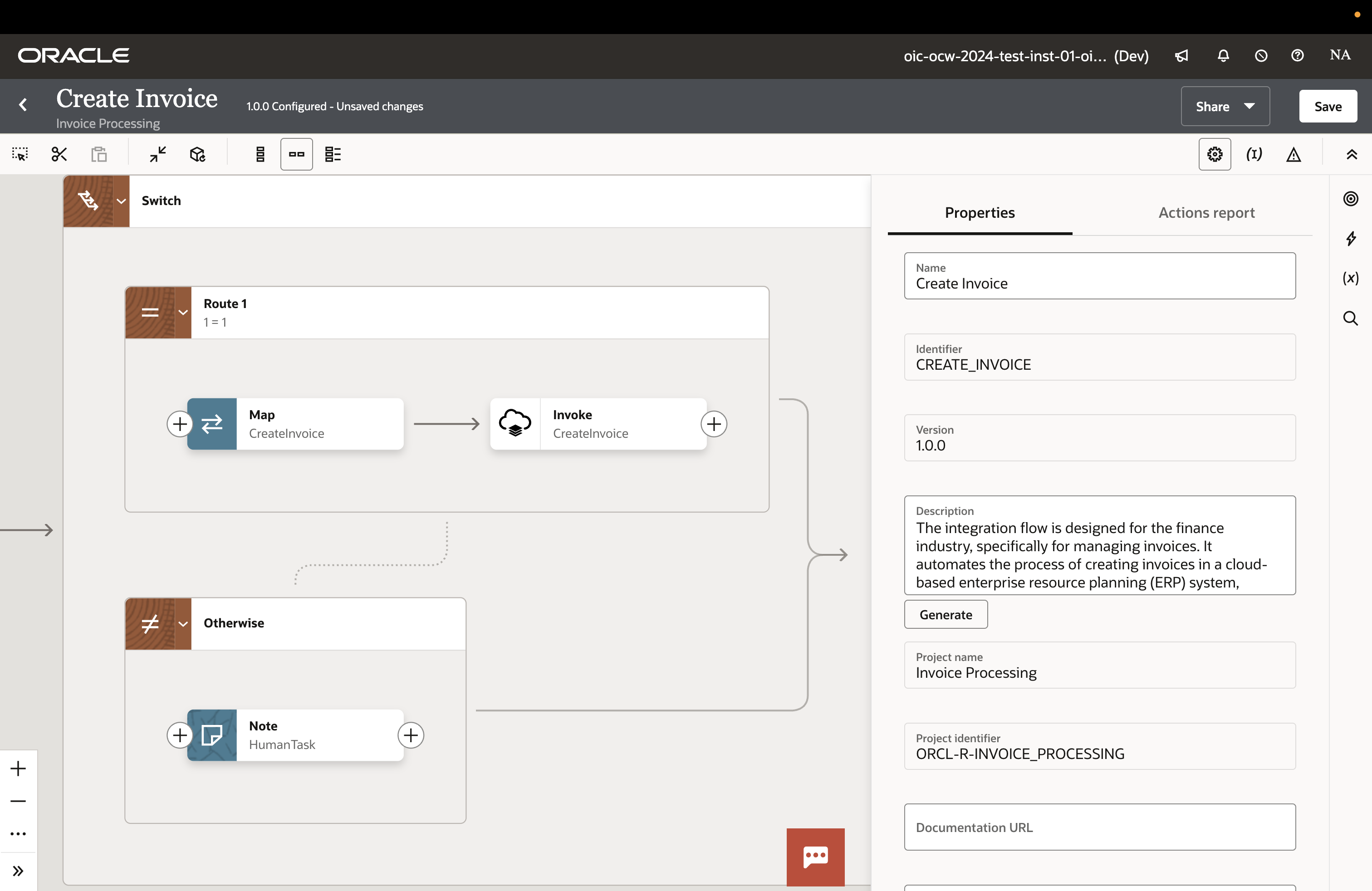
Bring Oracle Integration to AI
But you don’t need to wait for these new and exciting enhancements to start leveraging Oracle Integration for your AI innovations. Effective AI innovation relies on data consistency and transparent business processes. At its core, these are the very strengths OIC brings to the table. By connecting applications and data, and automating processes, OIC creates the foundation for innovation with AI.
Yet, even with a solid foundation, innovating with AI can seem daunting. Expectations are high and practical experience is low. We are building a roadmap and encouraging a customer journey that starts with proven, time-tested technologies and use cases where you can gain practical experience and confidence. Then build on those successes to expand into more sophisticated AI solutions as your understanding and comfort with the technology grows.
So, let’s explore some pragmatic examples where Oracle Integration can help with your AI innovation journey today.
AI-Powered Workflows
AI-powered workflows enhance traditional automation by embedding discrete AI services, enabling smarter decisions, automating specialized tasks, and reducing manual intervention within predefined processes. Oracle Integration provides a comprehensive multi-tier strategy for connecting to these AI services that focuses on time to value and technical flexibility.
- Oracle Integration now includes native Oracle Cloud Infrastructure (OCI) AI Service activities within both the Integration and Process Automation palettes allowing customers to easily incorporate these services into their workflows without the need for additional configuration or deep technical understanding of the underlying service operations.
- We will provide direct connectivity to orchestrate new Oracle AI Agents such as those from Fusion Applications AI Agent Studio and OCI Generative AI Agents.
- We continue to expand our pre-built adapter library to include connectivity to other popular AI services from providers like OpenAI, Anthropic, Meta, xAI, and Google.
- For those cases where we don’t have pre-built connectivity, customers can use our Rapid Adapter Builder (RAB) to create custom adapters to services they frequently use.
- And of course, almost all AI services can be accessed using our REST adapter.
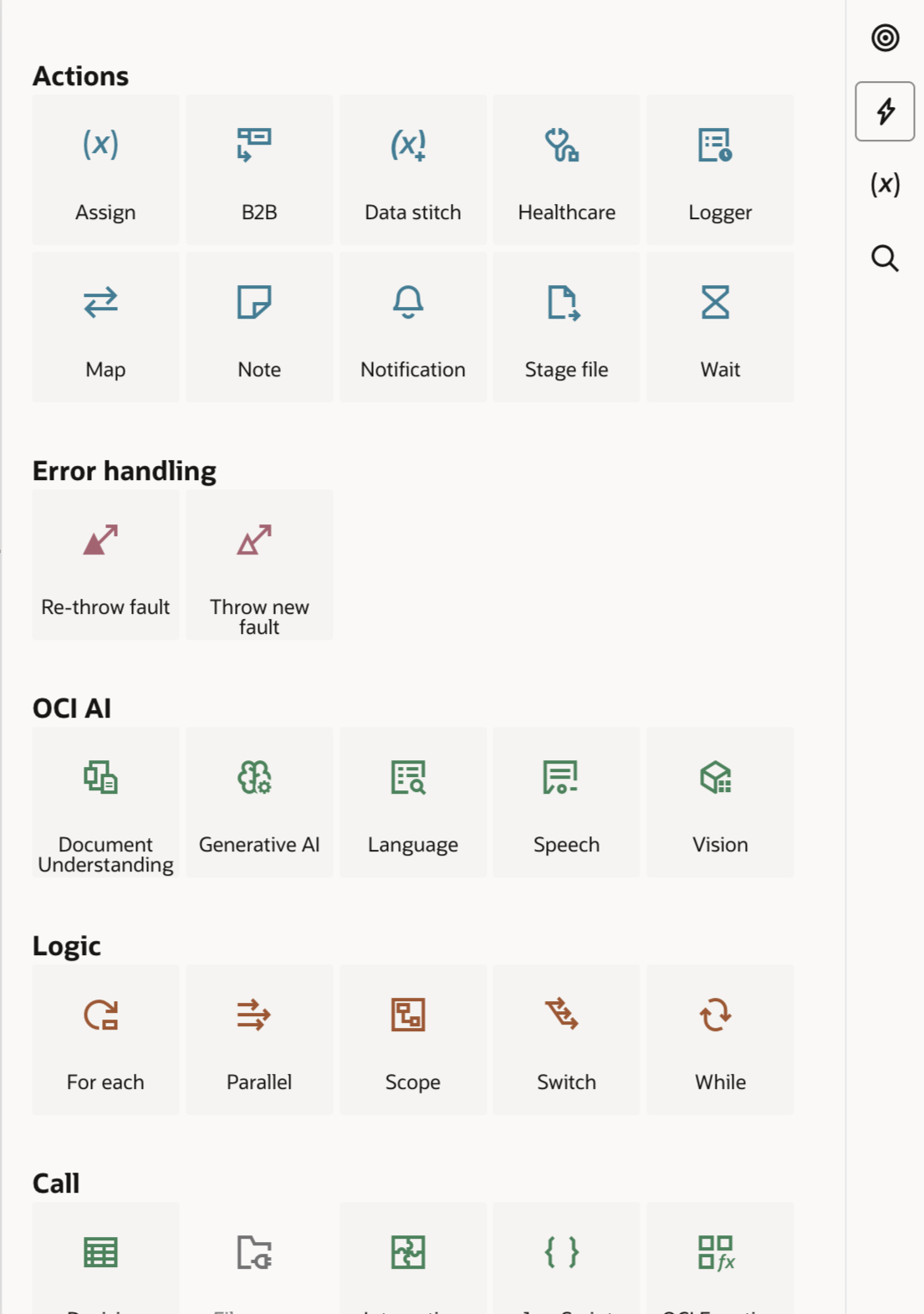
All of these connectivity options can be used to infuse your Integration and Process Automation workflows with the intelligence and efficiency of AI.
A couple of common examples of AI-powered workflows can be found in Intelligent Document Processing (IDP) and automated customer communication processing.
Intelligent Document Processing
One challenge faced by many businesses is high volumes of paper, PDF, and email content that requires manual processing and data entry, such as invoices, receipts, bank statements, and resumes. Intelligent Document Processing (IDP) can improve business efficiency, accuracy, and compliance by automating the data extraction, validation, approval, and processing of these documents. Oracle Integration is well suited to help implement IDP solutions by providing pre-built connectivity to AI services and enterprise applications, and process automation to provide human in the loop processing of exceptions and approval requests.
Automated Invoice Processing Use Case
A classic IDP use case is the processing of invoice documents. While many businesses process most of their invoices by other electronic means such as Electronic Data Interchange (EDI) or Procure-to-Pay (P2P) platforms, there often remains a persistent and non-trivial number of invoices that arrive as paper or PDF documents. An IDP invoice processing solution can be a part of a complete automation strategy that automates the processing of these invoice documents with similar speed and accuracy as electronic invoices.
The diagram below shows how Oracle Integration helps automate document centric invoice processing.

Automated Customer Communication Processing Use Case
Another example of using Oracle Integration to orchestrate AI services is the automated processing of customer communications. Social media channels create opportunities to drive customer loyalty, increase sales, and provide valuable market insights. However, the constant influx of communications from social media channels can overwhelm teams, leading to delayed response times, poor customer engagement, and brand erosion. Automating social media communications enables businesses to efficiently manage high volumes of customer interactions, ensuring timely and consistent responses. Again, Oracle Integration is well suited to help implement these types of solutions by providing pre-built connectivity to AI services and enterprise applications, and process automation to provide human in the loop processing of exceptions and approval requests.
The diagram below shows how Oracle Integration helps automate customer communication processing.
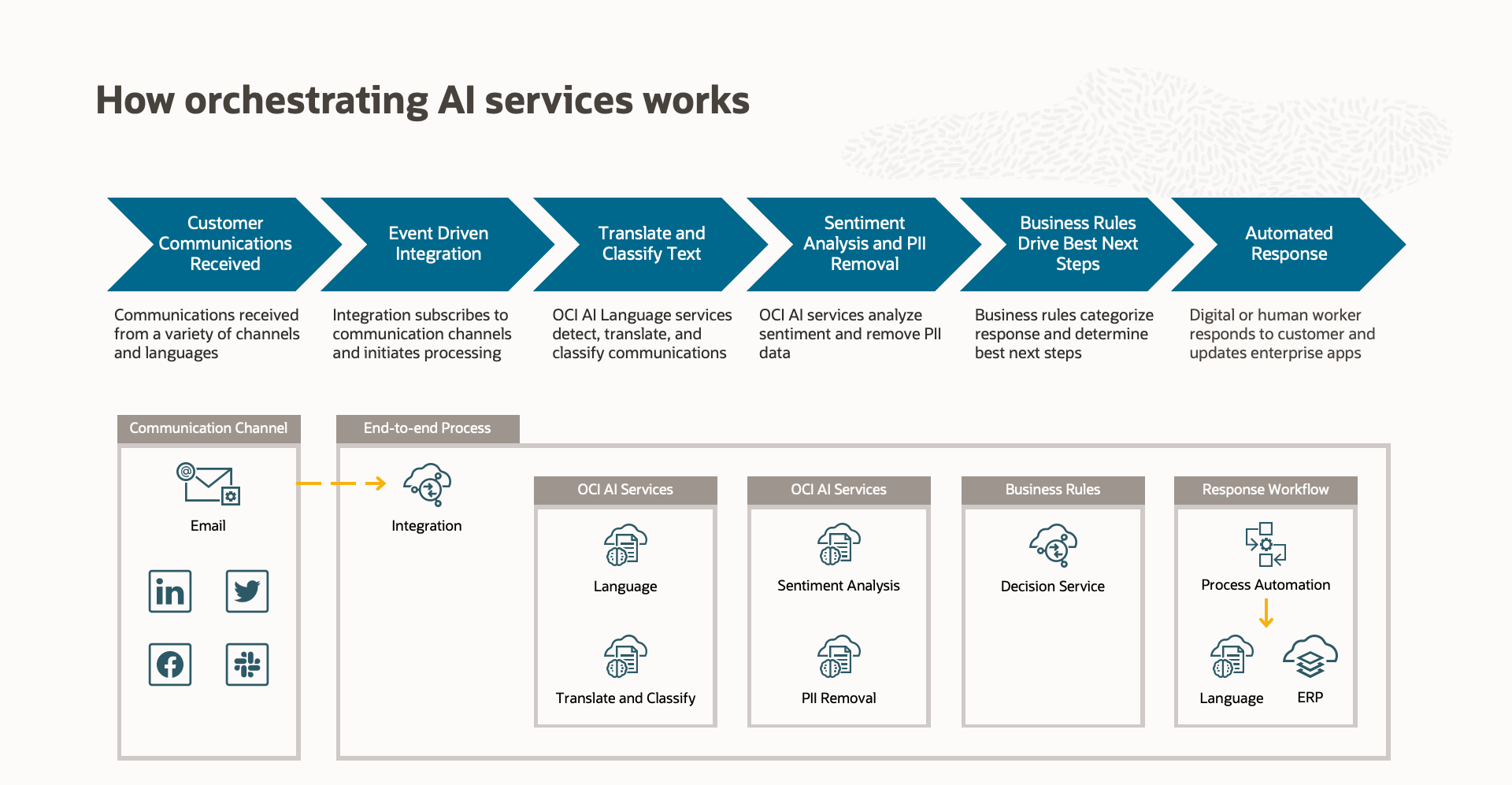
AI Agents
Business process automation is undergoing a generational evolution. Today, business process automation is characterized by pre-defined and rigid workflows designed to automate repetitive manual tasks. While this traditional approach is effective for highly structured operations, it lacks the adaptability needed to navigate complex and rapidly changing business conditions. AI Agents represent a fundamental shift, offering a new paradigm of automation characterized by self-direction and adaptability.
AI Agents automate business processes with various degrees of autonomy using Large Language Models (LLM) for planning, reasoning, decision-making, and task completion. These are the same large language models used by GenAI chatbot applications that facilitate conversational interactions like Q&A, content summarization, and content generation. AI Agents take the use of LLMs a step further. By leveraging their capacity to analyze and generate human content, these agents can reason over objective-based tasks, primarily defined through natural language objectives, guidelines, and constraints. These tasks can range from routine enterprise operations, such as document processing, or customer support triage, to complex business processes spanning multiple departments and systems across the enterprise, such as intelligent workforce planning or responding to supply chain disruption.
As part of this reasoning process, an agent can request access to external data and systems, providing it with real-time enterprise data and the ability to not only propose decisions, but take actions. For example, the agent may request data from a database, create a transaction against an enterprise application, engage human workers for clarification, exception handling, or approval, access corporate knowledge bases, or even coordinate with other agents on complex tasks.
At their core, AI Agents automate business processes and so inherit all the fundamental benefits of automation, such as operational insight, cost reduction, efficient resource utilization, and improved customer experience. However, the adoption of AI Agents offers additional compelling benefits for modern businesses seeking to enhance their operational efficiency and gain a competitive edge.
- One of the primary advantages is the speed with which these systems can be built. Since agent-driven business processes can be described as natural language objectives, guidelines, and constraints, both the development time and technical skillset demand are significantly reduced compared to traditional automation approaches. This ease of development empowers business users to directly contribute to the automation process, fostering greater alignment between business and technical teams. And these same efficiencies extend beyond initial agent development. When business requirements change, agent behavior can be modified with minimal effort by adjusting the natural language objectives, guidelines, and constraints.
- AI Agents exhibit remarkable adaptability due to the inherent reasoning capabilities of the underlying LLMs. Given access to a rich set of external resources, such as real-time enterprise data, agents can reason through unanticipated problems or circumstances to autonomously adjust their behavior. This natural ability to adapt, in conjunction with the ease of modifying objective, guideline, and constraint directives, position AI Agents as a powerful and flexible automation option to more effectively handle changes in business requirements, regulations, or market conditions.
- And finally, AI Agents empower businesses with enhanced decision-making. By rapidly analyzing real-time enterprise data, agents can provide actionable insights that would otherwise be time-consuming and difficult to uncover with human analysis. AI Agents can surface key insights and anomalies targeted to specific business needs, ensuring human decision-making and oversight is focused on the most relevant information. For example, agents can identify specific corporate policy violations in expenses or invoices, discrepancies in supplier contracts, or the best job candidates matching resumes with job requirements.
Oracle Integration AI Agents
Oracle Integration is adding AI Agents as a new automation component to further enhance our comprehensive portfolio of automation tools. This builds on our theme of a complete business automation platform, providing businesses a unified environment from application integration, RPA, process automation, B2B, to now advanced AI-driven automation. This platform approach provides our customers the choice to leverage the most appropriate automation technology for their business needs, hybrid solutions that incorporate multiple interoperating automation components, and supports an easy to navigate customer journey by building on your current investments towards more sophisticated AI-powered solutions.
Oracle Integration AI Agents will deliver all the key components necessary to build a successful AI Agent automation strategy.
- AI Agents require access to both public and private data sources as well as the ability to act on enterprise applications. These are typically called Tools in an agent architecture. You can leverage your current investments in integrations, RPA robots, and B2B transactions to provide your agents access to the tools they need. Our extensive library of pre-built connectivity adapters, recipes, and accelerators makes it easy to create agent tools that connect to Oracle and third-party Software-as-a-Service (SaaS) and on-premises applications, databases, internet technologies, and other AI services. And we will enhance Oracle Integration with new native activities such as Retrieval Augmented Generation (RAG) to make it easy to leverage unstructured private enterprise data using semantic knowledge bases built on technologies such as embedding models and vector databases.
- AI Agent behavior is largely defined by natural language objectives, guidelines, and constraints. However, they operate on these directives through an orchestration of several interacting components. These include the LLM for planning, reasoning, and decision-making, the agent’s transactional memory which tracks the steps it’s taken, user requests which provide the instructions for the task at hand, and the agent tools giving it access to external resources. You can think of this as a pattern that shapes how an agent interprets and executes its directives. Oracle Integration AI Agents will include a library of pre-built agent patterns for different types of agent behaviors. And since these agent patterns are based on integrations, you can leverage your current investments to create new patterns as the latest in AI advancements emerge or add custom guardrails to ensure agents are operating within your defined corporate governance, regulatory, and ethical boundaries. And we will be adding new adapters to support many of the leading LLM vendors, providing you the choice of which models are best suited for your business, technical, and governance requirements.
- AI Agents can operate autonomously, however it is highly likely that just as with your human workers, businesses will want to provide human oversight. This may be to provide the agent with additional clarity, handle exceptions, or approve work. Exactly when you decide to provide oversight will depend on your risk tolerance, comfort with the technology, and importance of the task at hand. Oracle Process Automation will be used to manage this human in the loop oversight. Using our robust task management and business friendly worklist, it will be easy to ensure your human workers are engaged based on your business and governance requirements.
- Of course, understanding and tracking an AI Agent’s actions is essential for trust, compliance, and continuous improvement. Auditability allows businesses to trace how an agent arrived at its conclusions, review past interactions, and ensure adherence to business policies and governance. Oracle Integration AI Agents will operate within our unified observability framework, making it easy to audit not only the steps an agent took, but how any other automation components were used as part of the agent execution.
- And finally, Oracle Integration AI Agents are not just for chatbot use cases. AI Agents can be configured to run on a schedule, initiated based on Fusion Apps or other events such as file server events, invoked from Integration or Process Automation to create hybrid orchestrated and agent-based workflows
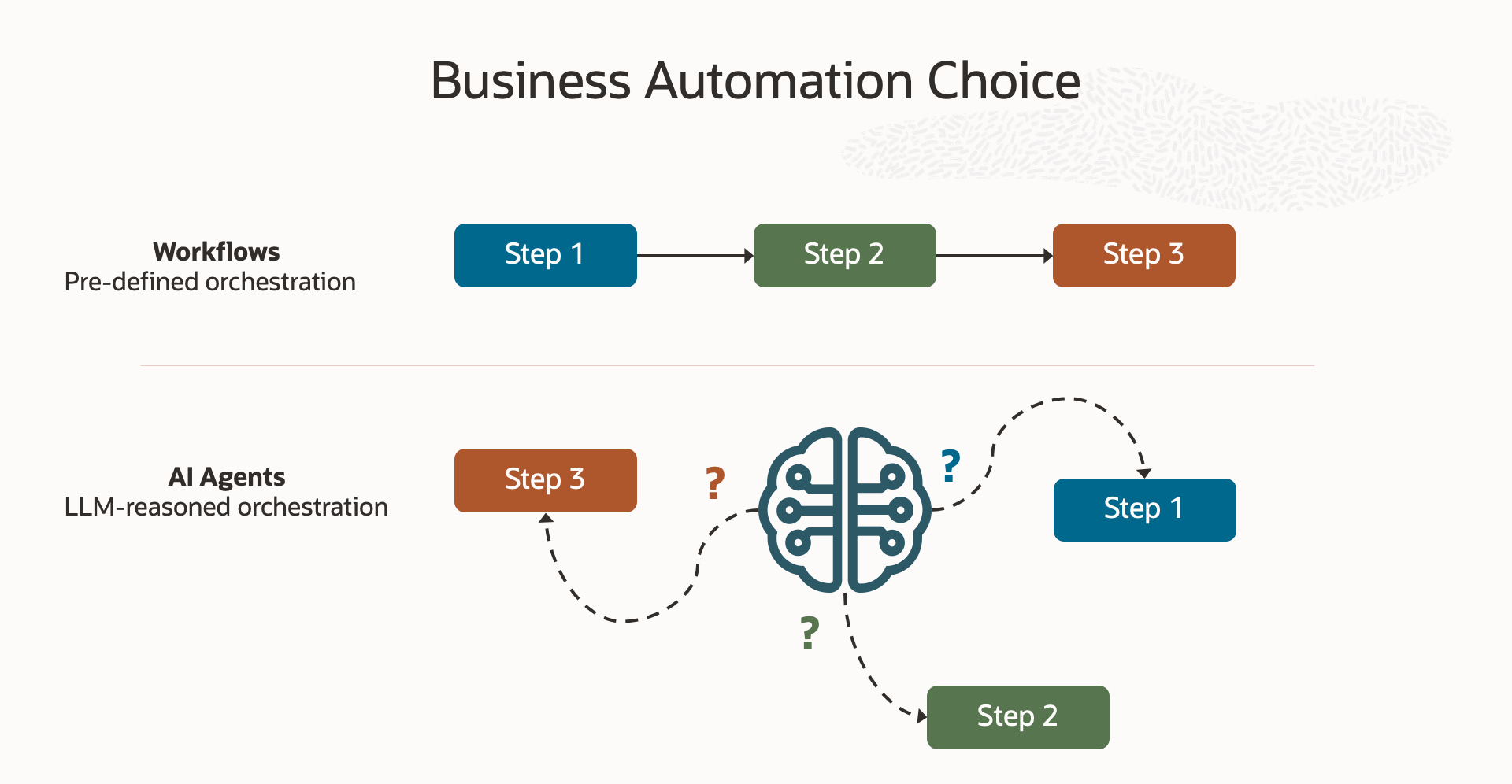
Conclusion
Oracle Integration stands ready to be your trusted partner in navigating the exciting landscape of artificial intelligence. With a robust foundation in integration and automation, and a clear vision for an AI-powered future, OIC offers pragmatic solutions today and promises even more intelligent capabilities tomorrow. Whether you’re looking to infuse existing workflows with AI or explore the transformative potential of AI Agents, Oracle Integration provides a unified platform to confidently embark on your AI innovation journey. Don’t hesitate to reach out and discover how Oracle Integration can help you turn the promise of AI into tangible business value.
Call to Action
Ready to start your AI innovation journey?
Contact us to learn how Oracle Integration can help you quickly deliver value through AI-powered automation.
We also invite you to join our early adopter program and help shape the future of AI Agents as we expand our unified automation platform.
